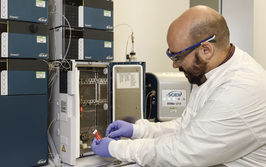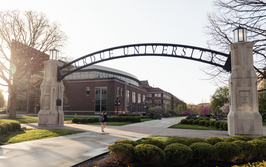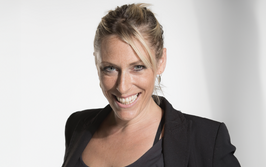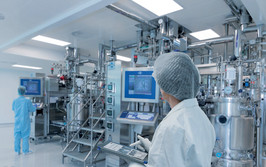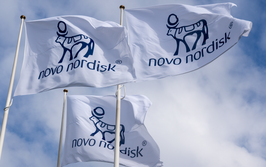Everybody Inspires
Sitting Down With… Claudia Zylberberg, Akron Bio Founder and ICST Presidential Nominee
| 7 min read | Interview
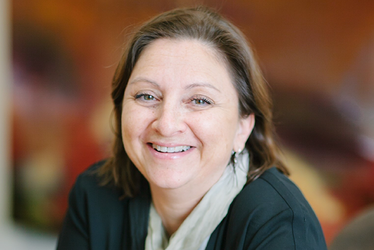
Who did you look up to growing up?
Rosalind Franklin and Marie Curie. I like strong women who have made a difference despite all the sacrifices they had to make in having families. I look up to them because they did it – in more difficult times and with more restrictions – and, if they can do it, I can do it too.
Where did it all begin for you personally?
I am curious and will look for things that nobody looks for. I was originally working in human plasma, but blood has cells so I wondered what they do, what could be done with them, and what value they could have. I began with the idea of banking the adult cells from blood and 20 years later I was able to use them to treat people. If the education system can harness, encourage, and expand on that kind of curiosity, we will have many more scientists.
You were nominated as a potential ICST President; how did that feel?
I was honored because it comes at a point in my career where I consider it is time to give back. There are years when you sow your seeds, you watch them grow and enjoy them, and then comes a time to think about all the elements of the environment that helped them grow and thrive. Taking what I’ve learned during my time at the standard coordinating body at the Alliance of Regenerative Medicine, National Academy of Sciences Regen Forum and helping in its evolution, I feel that I have all the knowledge and expertise accumulated to give back to the industry. It was a special moment when I was nominated by my peers and recognized with the contributions I’ve made to the industry.
And how does it feel to be named among the cell and gene pioneers of the world?
I’ve been in and around this industry from its infancy, when stem cells were something new and nobody knew what to do with them! Now it has mainstream, approved treatments. It has been a very rapid development. I’m extremely happy to know that the community recognizes me as an early contributor to the field – someone who has helped the industry grow.
What is your greatest achievement?
I built Akron Bio over the years and it’s a very special feeling now that patients are being treated with products that I helped develop. For some people, having an approved therapy is their biggest achievement, but for me it is knowing that these therapies and these products are helping people. It’s very fulfilling.
What else do you still hope to achieve?
I’m always looking for gaps and opportunities to find safe, affordable treatments, so I will keep building companies that can achieve this goal. I’m looking into the IL2 and IL15 proteins as adjuvants for cell therapies, and I’m looking at digitalization. There are perhaps gaps upstream where patient acquisition occurs and opportunities to help payers build affordability models. It’s one thing to have approved therapies, but another for patients to be able to afford them. That’s my next challenge: making sure therapies are affordable, that the system works, and that the science and manufacturing capabilities exist.
What were the initial challenges involved in founding Akron Bio?
Cell therapy manufacturing is a very different process to monoclonal antibody or protein manufacturing. There was a shift in mindset that needed to happen. There were 5–10 years that were not easy – when no one knew what stem cells were. No-one was talking about cell therapy or infusing cells in people; safety and regulatory bodies were still learning too. Everybody had to be open and flexible enough to understand that learning was part of the process. Akron has grown slowly and organically alongside the industry, developing a range of ancillary products and services. Changing mindsets is not easy. It takes a lot of effort, money, marketing, and education.
What kept you going?
It took some time, but I knew that the potential of this novel approach to incurable diseases could be a valuable paradigm changer. We just needed more adoption and understanding, as well as data, to confirm the potential in these novel approaches. We achieved it through participation with bodies such as the US Pharmacopoeia, the Standards Coordinating Body, ASGCT, ISCT, and ARM, creating book chapters, articles, white papers, and working groups – and it was also pretty fun. As an industry we collectively worked toward the main objective which we all believed in, that these therapies could be a game changer.
This experience gave me the opportunity to build new companies, so I created two additional companies, Arscience Bio and Kosten Digital, with the idea of looking into products and services to advance new treatments. Arscience to give adjuvants and opportunities to biologics to augment and combine with other entities to synergize therapeutics, and Kosten to provide digital solutions for AI and ML to enable the efficient global reach of healthcare solutions.
Who has inspired you along the way?
My grandmother was a great inspiration. She was the first woman to be a surgeon dentist in Argentina. Pinpointing one person would not be fair though, because everybody inspires. Everybody sparked my curiosity. This field is full of dreamers and passionate people that look to save the world from the most complicated and complex diseases. When everybody wants to make a difference, they work together. There were many people at Akron Bio; from a young generation of dreamers looking for cures, to big name researchers, such as Carl June, Jennifer Doudna, Michel Sadelain, Isabelle Riviere, and many others. I was inspired by many people – and I learned a lot from them. No matter their rank, all the people I encountered in my career were there for a reason, and they gave me purpose in my professional growth.
What’s the secret to influencing the next generation of cell and gene talent?
Education and “leaving a legacy” is a big part of what I love to do – and one of the most important things you can do for yourself and others. My children were extremely patient and flexible with me – especially when they learned how much their parents sacrificed. We were immigrants in the US, so we worked really hard to make it happen. That example, I think, taught them a lot and made them what they are today. Being a role model, and a mentor, is key.
Educating people on the opportunities that this field can bring is critical. There is no better patient than a well-educated patient. A better educated patient can make a difference – helping a physician form an opinion. It’s so important for the field to educate the next generation of patients on the effects of these new therapies so they can understand the value and ask for those treatments options. Educate payors, educate politicians: education is the key to moving the field forward. We only adopt what we understand. Knowledge is power. My children’s book You’re Full of Genes is a small contribution towards educating a younger generation on the power of our genes.
How far has the industry come – and what do you expect it to look like in the future?
There have been a lot of approvals, and a lot of people now understand that these options can make a difference. Cell and gene therapies are here to stay. I can see how, 30 years from now, cell therapies will be mainstream, and hospitals and centers will be able to provide them globally. People will live longer, and I believe opportunities in the gene editing space could cure diseases in utero, creating value in terms of cost for healthcare systems globally. Is not a matter of if, but when and how they could be delivered globally, and at what cost. The data of these clinically approved products will help create even better solutions and more cost-effective treatments.
The human body is very smart, and the knowledge and expertise that we have in cell biology and gene editing will create a set of tools that will be able to train the body to heal itself with the help of mainstream and affordable treatments. If we tackle that objective, we will all live longer, better lives.

